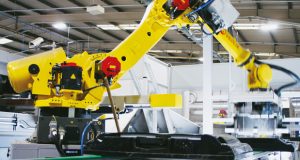 FMJ recently carried out a survey with ergonomics specialists DURABLE to gain insights into how FMs approach ergonomics in their organisation. Sam Rylands, DURABLE’s Marketing Manager offers a preview of some of the key results
FMJ recently carried out a survey with ergonomics specialists DURABLE to gain insights into how FMs approach ergonomics in their organisation. Sam Rylands, DURABLE’s Marketing Manager offers a preview of some of the key results
‘Ergonomics’ has been a concept that has grown in significance over the years. While in the past it was simply viewed as a necessary part of legislation that legally obliged employers to protect workers from the health risks of working with display screen equipment (DSE), such as PCs, laptops, tablets and smartphones; the understanding of the broader definition of workplace ergonomics has coincided with our increasing appreciation of wellbeing in the workplace. We now understand more about the impact that our working environments have on us, both physically and mentally. We appreciate that sitting under poor quality electric lighting leads to sallow skin and that hunching over our workstations leads to all sorts of health problems including strained eyes, sore backs and headaches.
Given that as a UK workforce we spend the majority of our working days sitting at our desks, we know that we should be doing more to improve our posture and set up our workstations to effectively manage and prevent these issues.
UK employers are legally obliged under HSE legislation(1) to protect workers from the health risks of working with. The recent study(2) undertaken by FMJ and workplace specialists DURABLE found that 90 per cent of UK companies do carry out DSE assessments in their workplace. This DSE assessment is carried out in many different ways either as part of the induction process with new starters, annually or via a self-assessment process using guidance supplied by the FM team. This positive story is slightly undermined by the fact that almost 40 per cent of those surveyed went on to say that the follow-up support given to employees as a result of the DSE assessment was ‘ad-hoc’ or provided ‘to some extent’.
ERGONOMIC SHORTFALLS
The wider definition of workplace ergonomics is to increase the comfort, safety and efficiency of employees by ensuring the equipment they use is right for their needs. It’s this element of ergonomics where a lot of UK companies also fall short of ideal.
Taking lighting as an example, a recent white paper(3) by workplace consultancy firm Baker Stuart stated that 70 per cent of employees are unhappy with the lighting in their workplace whilst a Raconteur study(4) found that only 57 per cent are satisfied with the light levels in their workplace. Given that a 60-year-old requires approximately two to two and a half times as much illuminance as a mid-20-year-old to achieve comparable vision, and as a nation we have an ageing workforce, action should be taken to install equipment which can provide all staff with the right level of comfort.
The WELL buildings standard(5) takes into account seven different elements of the workplace that contribute to the wellbeing, safety and efficiency of employees. Although WELL buildings are on the rise in the UK, many organisations simply can’t invest in brand new high performing accommodation for their staff. Of course, organisations can do more to make small changes to their existing workplaces to make a positive impact, but are there barriers to achieving this?
In the Workplace Ergonomics survey prepared by FMJ and DURABLE, 91 per cent of the survey participants stated that they have encountered barriers to implementing an ergonomic workplace. The most prevalent challenge selected was the perceived expense (48 per cent), closely followed by a lack of understanding across the workforce (44 per cent). Obvious answers to these obstacles is for organisations to gain more understanding of the benefits of ergonomics and educate the UK workforce about it.
Manufacturers of ergonomic solutions LUCTRA, who produce biodynamic human centric lighting, have evidenced(6) that their light increases its user’s productivity by 4.5 per cent, reduces errors by 1 per cent and also absenteeism by 1 per cent. Ergonomic workplaces can have a positive impact on a company’s bottom line, reducing sick days and increasing output, so it’s really a no brainer for companies to invest in ‘healthy’ equipment.
As for education, it seems like we need more organisation’s to actively gather employee feedback to understand what their staff think of their working environment and what they may need to perform their roles more effectively whilst maintaining their wellbeing. FM’s can play a pivotal role in driving these changes and making a positive impact on the state of our workplaces.
The Workplace Ergonomics Report 2020 from FMJ and DURABLE will be available soon.
▶ 90 PER CENT OF UK COMPANIES CARRY OUT DISPLAY SCREEN EQUIPMENT (DSE) ASSESSMENTS IN THEIR WORKPLACE
▶ NEARLY 40% ADMIT THAT THE FOLLOW-UP SUPPORT GIVEN TO EMPLOYEES AS A RESULT OF THE DSE ASSESSMENT WAS ‘AD-HOC’ OR PROVIDED ‘TO SOME EXTENT’
▶ 91 PER CENT HAVE ENCOUNTERED BARRIERS TO IMPLEMENTING AN ERGONOMIC WORKPLACE
▶ GREATEST CHALLENGE WAS THE PERCEIVED EXPENSE (48%), CLOSELY FOLLOWED BY A LACK OF UNDERSTANDING ACROSS THE WORKFORCE (44%)
REFERENCE NOTES
(1) https://www.hse.gov.uk/msd/dse/
(2) https://www.fmj.co.uk/workplace-ergonomics-survey-2020/
(3) https://bakerstuart.com/white-paper/enlightened-thinking-workplace-lighting/
(4) https://raconteur.uberflip.com/i/762006-the-stoddart-review-the-workplace-advantage-broadsheet/4
(5) https://www.wellcertified.com/certification/v1/standard/
(6) www.luctra.eu/en/news/article/new-study-about-luctrars-innovative-lighting-technology/




